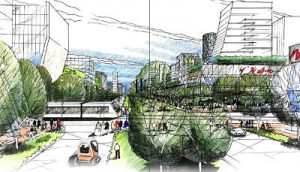Forget sterile riverfront ghettos of luxury high-rise apartments, these days it’s a Green Star that sells big new city builds.
Australia’s largest inner-urban redevelopment project, the massive industrial zone of Fishermans Bend on Melbourne’s Yarra River, will now officially be Green Star rated blend of mixed residential and commercial buildings embedded into abundant parkland and served by a new industries employment hub that overtly shuns private car use for public and active transport.
That’s the latest vision for what was once Melbourne’s sprawling industrial and manufacturing heartland as it attempts to transform to become home 80,000 residents and 60,000 workers serviced by new rail, tram and bus links bolstered by dedicated walkways and cycle paths for commuters.
And it’s just doubled in size.
Victoria’s Daniel Andrews Government (Labor) late last week moved decisively to “recast” the masterplan for the giant area, most notably upping its total development footprint size from around 250 hectares outlined in 2012 to 465 hectares – but significantly it also mandated ‘Green Star’ requirements to embed sustainability.

It flips the position of the previous Baillieu-Napthine Government (Coalition) – which only lasted one term in office – that had made a point of snubbing any real mandate to enforce sustainability requirements on the huge development on the basis the standards created unnecessary ‘Green Tape’.
With local governments, developers, property investors and planning experts all supporting the Green Star measures, it was at best a confused start to what many believe will become Australia’s exemplar of a new-age urban environment.
Snatching an easy political free kick, the Andrews government wasted little time in locking down sustainability requirements that have gone from being a ‘nice-to-have’ credential for office and home buyers to something that actively lifts property values.
Deprioritising private car travel is a major feature of the new masterplan, as is heavily diversifying the blend of developments to mix in more affordable dwelling stock with a big nod to the area’s industrial past by creating a “network of gritty streets and laneways.”
“Fishermans Bend needs to be designed to encourage residents and commuters to get around by walking, cycling or catching public transport. The Victorian Government—via the Taskforce—will develop a flexible and adaptable plan that meets this need,” the new Draft Report report says.
Citing Plan Melbourne 2016, the vision outlined for “housing supply, diversity and choice” says it will now “have a stronger emphasis on getting more diverse and affordable homes built—articulating long-term land use policies and reforms to meet projected housing needs and expand housing choice and affordability.”
Green with envy
It’s a logical step given that commercial and residential property developers, not to mention more and more high profile corporations and business groups are now openly embracing and promoting green building designs to cultivate kudos with customers, investors and staff by showing they care.
Part of the big appeal is that Green Star-rated buildings don’t just have lower emissions and a smaller environmental footprint, they generally have substantially lower running costs too, making them more commercially appealing.
The Green Building Council of Australia (GBCA), which developed the Green Star building ratings standard to guide the planning of sustainable communities and precincts, is chalking up the move to mandate its ratings at the Fishermans Bend development as a very big win.
“This is something industry has been calling for over a number of years, and we are delighted that the Andrews Government has responded so positively,” said GBCA chief executive, Romilly Madew.
“The significance of the site, the scale of the project, and the far-reaching implications of ‘getting it right’ make achieving a Green Star – Communities rating an essential component of smart, sustainable planning.”
But it’s the strong backing of the Property Council of Australia for the Green Star ratings that perhaps most conspicuously drives home the appetite of major business groups to be seen to be acting on sustainability, even if it sometimes means being politically incorrect.
“Three years ago the Property Council urged the Government to endorse the Green Star – Communities rating tool at Fishermans Bend to support sustainable, resilient and liveable communities,” said the Property Council of Australia’s Acting Victorian Executive Director, Asher Judah.
“It is exciting to see the Government commit to this important sustainability reform.”

What will Fishermans Bend look like now?
With sustainable, liveable cities now at the front of many state and the federal government’s planning agenda, Victoria’s Planning Minister Richard Wynne is heavily pushing the need for government to get the key infrastructure building blocks for major infill projects right from the design phase.
In the introduction of the “recast” Fishermans Bend Draft plan, he takes clear swipe at the short-term trend to maximise yields by throwing up stand-alone high-rise apartment complexes.
“We need to tackle challenges such as public transport, schools, community services and public spaces now, rather than putting up residential towers and hoping for the best,” Mr Wynne said.
“Fishermans Bend has a rich history,” he says. “It was the birthplace of Australia’s aviation industry and, for decades, was the heart and soul of Australia’s automotive manufacturing. Now, we have the chance to make it a benchmark for smart, sustainable development and high-density community living.”
To give Melburnians a sense of what Fishermans Bend can become, the draft vison document put out by the government tries to outline the development by presenting it in a “future perspective” – or writing about it in the present tense as if it’s now 2050.
“Known as backcasting, this technique describes a future we would like to see, then identifies the strategies required to make that future attainable,” the paper says.
“Melbourne is a now a city approaching 8 million people and experiences more hot days and extreme weather events. The city also operates in an increasingly connected and competitive global environment. Fishermans Bend plays a vital role in ensuring that Melbourne meets the challenges and seizes the opportunities of this changing world,” says one futuristic passage.
“A generous tree canopy keeps Fishermans Bend cool in summer. Not only are the public spaces green – so, too, are the buildings. The buildings incorporate vertical and roof-top greening—saving water while supporting a rich biodiversity throughout the area. A network of leafy boulevards and green links connect neighbourhoods and public spaces, providing a focus for city life as well as high quality public transport, walking and cycling
Infrastructure,” says another.
One of the more radical visons for the dense-but-green model cluster of communities is the removal of cars from the transport mix.
“Car parking has been reduced. In fact, less than one-in-five trips are now made by private car. Instead, the efficient and direct public transport network reduces traffic congestion and carbon emissions,” the draft vison says.
Also in the mix are “strong links” of dedicated cycling and walking links across the new suburbs – five in total, as well as purpose build water recycling.
The draft vision also clearly wants to grab the opportunity to make the massive development an enviable place to work, dedicating a large tract of land to become what it says should become “Australia’s leading design, engineering and advanced manufacturing precinct”.
“The Fishermans Bend Employment Precinct is a world renowned location for innovative industries, attracting international investment and producing world-leading research, engineering, technology and products. Its economy is highly productive and profitable, but with a low environmental impact, and complements Fishermans Bend as a whole through compatible land uses,” the draft vision says.
If that sounds familiar, it could be because the description could be used in a sales brochure for almost any commercial office park in Australia, many of which – like Sydney’s Australian Technology Park in Redfern – ultimately become drive-in, drive out affairs for day workers and ghost towns at night.
Or Canberra, which has until recently struggled badly to create any kind of cosmopolitan vibe after dark thanks to heavy planning designations that for decades segregated commerce, work and industry from residential areas.
There may still be many unanswered many questions around the latest incarnation for Fishermans Bend, but at least Melbourne is daring to dream again.





Leave a Reply